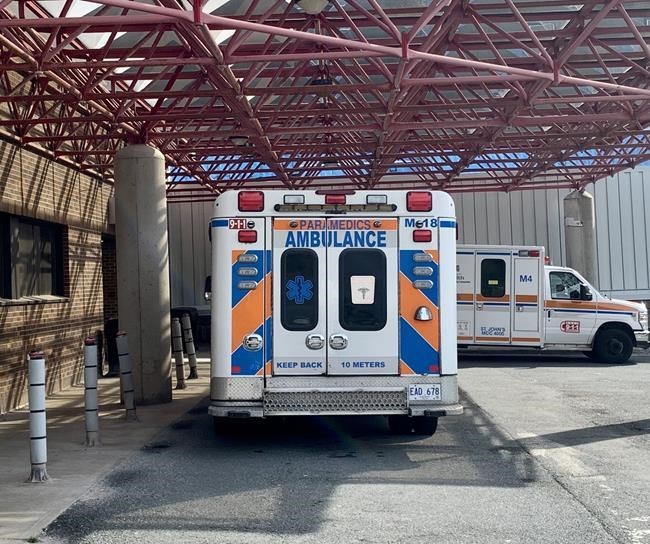ST. JOHN'S, N.L. — First responders in rural Newfoundland say they're not surprised by data showing deaths in the province's emergency departments jumped by 24 per cent in 2022 from the previous year.
Jamie Budden, the fire chief in Whitbourne, N.L., says sick or injured people in his area must travel much farther since the local emergency room closed "temporarily" last June and never opened back up. The distance also ties up ambulances for longer, which can add even more time to a patient's wait for critical care, he said.
"If Nan or Pop gets a chest pain, 7 o'clock in the evening, they're that much farther from an emergency room," Budden said in an interview. "So, do they make it? Do they not make it? … This stuff needs immediate attention, not two hours later when you can get through a snowstorm."
Data from Newfoundland and Labrador's Health Department shows 326 people died in the province's emergency departments in 2022, up from 262 in each of the previous two years. In 2019 and 2018, there were 266 and 283 emergency department deaths, respectively. The data may include those who died before they arrived at the emergency room.
In an emailed statement, the department said it "reviews data available across the health-care system on an ongoing basis, and does not speculate regarding (the numbers)."
Eastern Health, the province's largest health authority, which includes the hospital in Whitbourne, also refused to comment on the numbers.
In January, Nova Scotia health officials spoke to reporters after the province's New Democrats released numbers showing emergency department deaths in that province had jumped by 10 per cent, to 588 in 2022 from 505 the year before. A director with Nova Scotia Health said the jump was not unexpected, as more patients — and sicker patients — were seeking emergency care in the province.
Dr. Kris Luscombe, president of the Newfoundland and Labrador Medical Association, said that as a psychiatrist, he is also seeing patients with "very severe cases" turn up in the emergency room.
"I'm seeing some the sickest patients in the emergency department that I've seen in a decade," Luscombe said in an interview. "And it does make me wonder how much of that is occurring."
The spike in emergency department deaths in Newfoundland and Labrador is concerning, he said, adding that the province's family doctor shortage is partly to blame. When patients lose their family doctor, they lose access to preventive care like regular checkups and screenings, he said. They may also delay seeking care when they fall ill because their only option is the emergency room, where wait times can stretch into the night, he added.
"And you have to wonder, again, if that increases risks for more serious conditions or negative outcomes," Luscombe said.
Michael Tiller is the mayor of New-Wes-Valley, N.L., where he also works as a paramedic. He said he's also not surprised by the jump in emergency room deaths; his community hit "rock bottom" in late 2022 when there were no doctors to regularly staff the local hospital, he added.
"It was horrible," Tiller said in an interview. "Every call that you went on, you knew you had extra transport time, and you knew that the patient was probably going to be a little sicker than they would have been had everything been running smoothly."
Whitbourne is about 90 kilometres west of St. John's, just south of the Trans-Canada Highway. Before the local emergency room was closed week after week, it served an area home to about 20,000 people, Budden said.
It also served a lot of people who had been in vehicle crashes on the main highway. He said that waiting with crash victims for an ambulance to return from an open emergency room in Carbonear, N.L., or St. John's has become increasingly stressful. So, too, is helping load them onto an ambulance that will travel at least an extra half hour, he said.
"Lately, sometimes I wonder, do they make it?" Budden said. "And a lot of times, I just don't know."
In New Brunswick, the Vitalité Health Network supplied numbers showing a five-year peak in 2021, with 267 deaths. In 2022, the number fell to 208. The province's Horizon Heath Network did not supply any figures.
Prince Edward Island also saw a spike in 2022, with 48 reported emergency department deaths, up from 32 the year before. The province hit a five-year high in 2018, with 49 deaths.
This report by The Canadian Press was first published Feb. 28, 2023.
Sarah Smellie, The Canadian Press




